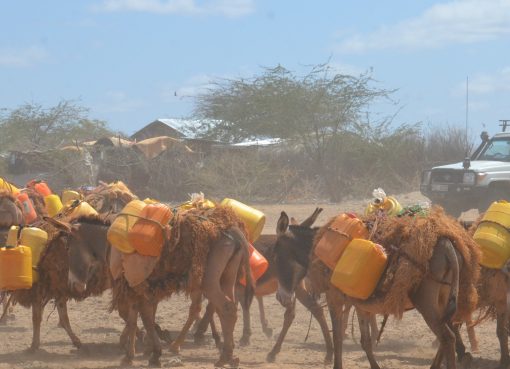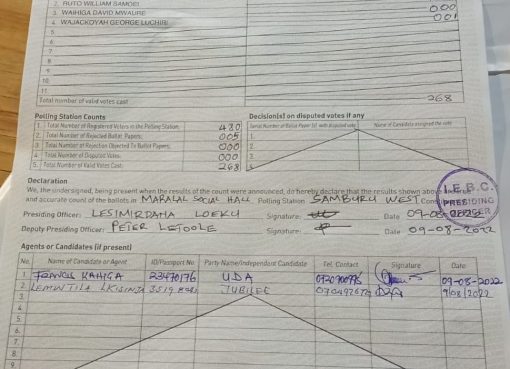The government has set aside a provisional budget of Sh2.282 billion for the provision of relief assistance to people affected by drought across the country.
Government spokesperson Col. (Rtd) Cyrus Oguna said that currently over 1.4 million Kenyans are at risk of hunger and starvation, and potentially face acute food insecurity.
“However, the Government is committed to ensure that no Kenyan dies from lack of food. The National Government in collaboration with county Governments of the affected counties have initiated interventions which include close monitoring of areas that may be threatened for immediate response,” explained Oguna.
Speaking Thursday at the government media center during a media briefing, Oguna said that County Governments in collaboration with the National Government have rolled out a plan to assist the affected areas which include distribution of water to households in the counties of Turkana, Mandera, Garissa and Wajir.
“The intervention measures also include provision of relief food in Turkana county by the County Government, cash transfer under the Hunger Safety Net Program which is currently in Phase 3 where every household receives Sh2,700 every two months, and targets over 101,800 households in the Counties of Turkana, Mandera and Marsabit. The Government spends about Ksh.2 billion on the program every year,” he said.
The government spokesperson said that plans are underway to incorporate into the program the Counties of Wajir, Isiolo, Tana River, Garissa and Samburu.
“Other Safety Net Programs such as Inua Jamii form part of the interventions which continue to be implemented. The government has also availed subsidized seeds, fertilizers and a wide range of farm inputs to increase small-scale farms productivity. This program targets over 1.4 million small scale farmers in 37 Counties,” he said.
Oguna called on other Development partners such as UNICEF, World Food Program, UNDP, NGOs, the Private Sector and other individuals of goodwill to step in and help with the provision of relief aid.
The spokesperson said that according to the Meteorological Department, the expected rainfall during the long rainy season is likely to be depressed, with only a few areas in the regions of Nyanza, Western, Central, parts of Rift Valley and Eastern are likely to receive above average rainfall.
“Other regions are expected to receive below average rainfall or none. These are the Counties of Mandera, Wajir, Garissa, Isiolo, Marsabit and Tana River. Some parts of these counties, including Marsabit, Tana River, Isiolo and Turkana are already experiencing drought stress,” he explained.
He highlighted that the overall food security in the country is good. However, due to the poor performance of the short rains in the months of October-December 2020, the national food and nutrition security was marginally compromised. The situation has been compounded further by the COVID-19 pandemic, and the desert locust invasion.
“The projected annual production of maize for the year 2020 was 43.2 million of 90 kilograms bags of maize, against the country’s annual requirement of 47,000,000 bags. The actual harvest for that year was 41,551,550 bags, translating to a deficit of about 5,500,000 bags, which was offset by importation of the commodity from the region,” explained Oguna.
He said that with the performance of the 2021 long rains season forecast to be poor, the situation is likely to dip a little, and the number of those in need of humanitarian support likely to increase towards August 2021.
“The Government wishes to advise farmers to take advantage of the input subsidy to increase their productivity. In areas likely to experience depressed rainfall, farmers are encouraged to plant drought-tolerant and early-maturing cereals and legumes such as cow peas, pigeon peas, Green grams, sweet potatoes, millet, sorghum and beans,” said Oguna.
He also called on farmers to use appropriate fertilizers for planting and top-dressing procured only from registered agro-dealers at the recommended price range of Ksh.3100-3400 for planting and Ksh.2300-2900 for top dressing.
“Kenyans who live in areas that are perennially threatened by floods such as Nyando, Nyatike, Budalangi and Tana River to consider moving to safer grounds during heavy rainfall. Those living in mud-slide prone areas such as West Pokot, Elgeyo Marakwet and Muranga to also consider moving to safer areas,” said Oguna.
He called on individuals living near the swelling Rift Valley lakes to move to safer grounds since the lakes are likely to continue rising during this period while also encouraging Kenyans in the areas likely to experience heavy rainfall to take advantage of the rains and plant trees.
On the locust invasion situation in the country, Oguna said that there has been remarkable progress made with the containment efforts.
“Control and containment efforts by the Government in collaboration with the County Governments and other Development Partners such as FAO, World Bank, among others, have managed to reduce the swarms to only three. These have split into small swarmlets which are currently concentrated around Gilgil and Elburgon in Nakuru County. Efforts continue to be applied to ensure that the last of the swarmlet is contained. The estimation is that the locust invasion should have been effectively contained by mid-April 2021,” said Oguna.
By Joseph Ng’ang’a





